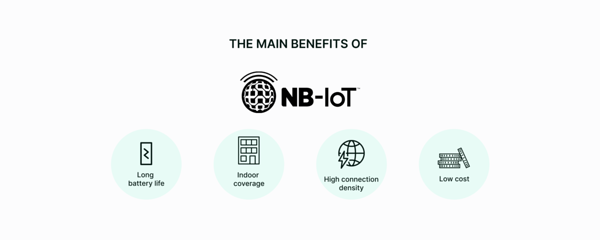Narrowband Internet of Things (NB-IoT) is an LPWAN radio technology. Built according to the LTE standard, it limits the bandwidth to a single narrowband of a maximum of 200kHz.
You might have heard the term LTE Cat-NB1 used instead of NB-IoT, but it's referring to a specification released in 2016.
Now, there are also Cat NB2 devices available that use the new and improved NB-IoT specifications. The main difference between this and the older version is improved downlink and uplink data rates.
It's important to note that Cat-NB2 devices provide better mobility. They also support reconnecting when the device is in the connected mode, as opposed to idle mode only in NB1. These categories came out with the 3GPP Release 14 and are currently on the road toward commercialization.
Deploying with NB-IoT
NB-IoT modules are the cheapest cellular modules on the market. Hence, companies tend to look for LPWAN connectivity but forget to consider the functionality and use case in addition to hardware costs.
NB-IoT can be deployed "in-band" within a standard LTE carrier or "standalone" for deployments in the dedicated spectrum. It means that even though NB-IoT can perfectly co-exist with 2G, 3G, and 4G in a device, devices currently operating on 2G, 3G, and 4G don't automatically support NB-IoT.
NB-IoT is designed to work with stationary devices that can stay connected to one network, as switching networks is a very time-consuming process for these devices. However, it supports an excellent battery life for many use cases, possibly exceeding the 10-year mark.
What are NB-IoT's main limitations?
NB-IoT seems like an attractive option due to cheaper hardware and good battery life. However, there are significant shortcomings that you need to be aware of before opting for hardware that only supports NB-IoT.
Firstly, NB-IoT does not have SMS services as a requirement, so although some operators include SMS support in NB-IoT, it's not guaranteed. This will make it much harder to communicate with the device over cellular if something goes wrong. Instead of sending an SMS to troubleshoot or reboot the device, you will have to reach the device physically.
Lack of SMS capabilities also means your device won't be able to support eSIM technology, as SMS is required to trigger profile downloads on eSIM.
Another issue is that we don't have a reliable overview of where NB-IoT is actually available. There might be NB-IoT networks available within a country, but it’s highly unlikely that you would get reliable connectivity everywhere, as NB-IoT is still in its infancy and very spotty.
Finally, as mentioned earlier, while NB-IoT can keep devices connected when they move, it is incapable of cell tower handover. This means that reconnecting to a network will take a long time and increase power consumption.
What should you consider before choosing NB-IoT modules?
If you need your devices to run on NB-IoT, ensure your cellular module also has another communication standard as a fallback. This will ensure you won't be locked in with a device that can only use low-power networks when the standard is unavailable. This can happen if your devices need to operate in several regions.
The Role of NB-IoT in 5G
As we leap into the future with 5G technology, NB-IoT is expected to play a significant role. It presents a cost-effective solution for massive IoT deployments, a key use case for 5G networks. With the ability to support low latency, high throughput, and multitudes of devices, NB-IoT is well-positioned within the 5G ecosystem.
Looking at the future, according to ABI Research, NB-IoT and LTE-M will capture over 60% of the 3.6 billion LPWA network connections by 2026.NB-IoT versus LTE-M
LTE-M (abbreviation for LTE Cat-M1/M2) is, just like NB-IoT, an alternative LPWAN technology. This technology is created for IoT devices to connect directly to a 4G network without a gateway and using only batteries. However, compared to LTE-M, NB-IoT poses more limitations for your deployments:
- For example, since NB-IoT is incapable of cell tower handover, it's only suitable for stationary devices. On the other hand, LTE-M is suitable for both stationary and mobile devices.
- Both LTE-M and NB-IoT technically support eSIM. However, since NB-IoT specification doesn't have SMS services as a requirement, your devices might be unable to download eSIM profiles.
- LTE-M supports voice functionality via VoLTE (voice over LTE) and can be used for applications requiring human interaction. Unfortunately, that can't be said about NB-IoT, which doesn't support voice functionality.
We’ve also written in more detail about LTE-M and compared the two LPWAN radio technologies. You should also read our article on how to choose the best communication technology for your use case.





